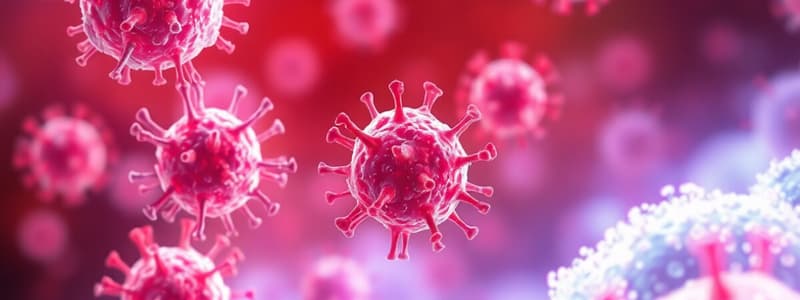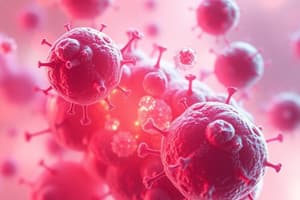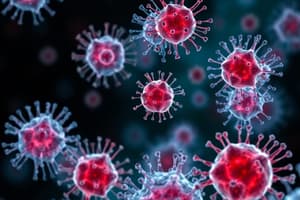Podcast
Questions and Answers
What type of immunity is primarily mediated by T lymphocytes?
What type of immunity is primarily mediated by T lymphocytes?
- Innate immunity
- Cell-mediated immunity (correct)
- Complement activation
- Humoral immunity
Which T cell subset plays a significant role in combating intracellular pathogens?
Which T cell subset plays a significant role in combating intracellular pathogens?
- CD4+ Th1 cells (correct)
- CD4+ Th2 cells
- Regulatory T cells
- CD8+ T cells
How do CD8+ cytotoxic T lymphocytes eliminate infected host cells?
How do CD8+ cytotoxic T lymphocytes eliminate infected host cells?
- By producing cytokines
- By secreting antibodies
- By direct cell killing (correct)
- By activating regulatory T cells
What is the primary function of CD4+ Helper T cells?
What is the primary function of CD4+ Helper T cells?
What characterizes delayed hypersensitivity?
What characterizes delayed hypersensitivity?
Which cytokine is primarily produced by Th1 cells to aid in the defense against microbes?
Which cytokine is primarily produced by Th1 cells to aid in the defense against microbes?
Which of the following is NOT a characteristic function of regulatory T cells?
Which of the following is NOT a characteristic function of regulatory T cells?
What is a primary mechanism by which CD4+ Th2 cells defend against helminths?
What is a primary mechanism by which CD4+ Th2 cells defend against helminths?
Which factor is primarily responsible for directing the differentiation of activated CD4+ T cells?
Which factor is primarily responsible for directing the differentiation of activated CD4+ T cells?
What is the primary function of Th2 cells in the immune response?
What is the primary function of Th2 cells in the immune response?
What effect does the balance between Th1 and Th2 cell activation have?
What effect does the balance between Th1 and Th2 cell activation have?
Which mechanism allows CD8+ T cells to induce apoptosis in infected cells?
Which mechanism allows CD8+ T cells to induce apoptosis in infected cells?
Which cytokine is primarily associated with the activation of effector CD4+ T cells?
Which cytokine is primarily associated with the activation of effector CD4+ T cells?
What role do adhesion molecules play in the function of CTLs (cytotoxic T lymphocytes)?
What role do adhesion molecules play in the function of CTLs (cytotoxic T lymphocytes)?
What is a characteristic feature of lepromatous leprosy?
What is a characteristic feature of lepromatous leprosy?
How do granzymes contribute to the function of CTLs?
How do granzymes contribute to the function of CTLs?
What determines the differentiation of naive CD4+ T lymphocytes?
What determines the differentiation of naive CD4+ T lymphocytes?
What immune response do Th2 cells primarily mediate?
What immune response do Th2 cells primarily mediate?
Which transcription factor is primarily activated by cytokines to influence T cell differentiation?
Which transcription factor is primarily activated by cytokines to influence T cell differentiation?
What is the effect of a balance between Th1 and Th2 cell activation?
What is the effect of a balance between Th1 and Th2 cell activation?
In the context of leprosy, what leads to the development of tuberculoid form?
In the context of leprosy, what leads to the development of tuberculoid form?
How do cytotoxic T lymphocytes (CTLs) primarily induce apoptosis in target cells?
How do cytotoxic T lymphocytes (CTLs) primarily induce apoptosis in target cells?
What role do granzymes play in the immune response?
What role do granzymes play in the immune response?
What is the function of adhesion molecules in the interaction between CTLs and infected cells?
What is the function of adhesion molecules in the interaction between CTLs and infected cells?
What is the primary role of CD4+ Th1 lymphocytes in cell-mediated immunity?
What is the primary role of CD4+ Th1 lymphocytes in cell-mediated immunity?
Delayed hypersensitivity reactions are mediated mostly by which type of immune cell?
Delayed hypersensitivity reactions are mediated mostly by which type of immune cell?
What function do CD8+ cytotoxic T lymphocytes perform in the immune response?
What function do CD8+ cytotoxic T lymphocytes perform in the immune response?
Which cytokine is a key component produced by Th1 cells to aid in their immune response?
Which cytokine is a key component produced by Th1 cells to aid in their immune response?
What distinguishes regulatory T lymphocytes from effector T lymphocytes?
What distinguishes regulatory T lymphocytes from effector T lymphocytes?
The differentiation of CD4+ T cells into Th2 cells is primarily driven by which of the following?
The differentiation of CD4+ T cells into Th2 cells is primarily driven by which of the following?
Which subset of CD4+ helper T cells is primarily involved in the defense against helminths?
Which subset of CD4+ helper T cells is primarily involved in the defense against helminths?
What is an essential characteristic of Th1 CD4+ effector T lymphocytes?
What is an essential characteristic of Th1 CD4+ effector T lymphocytes?
Flashcards
Cell-Mediated Immunity (CMI)
Cell-Mediated Immunity (CMI)
This branch of the immune system, often called CMI, involves cells, particularly T lymphocytes (T cells), in targeting and destroying pathogens. It primarily focuses on eliminating intracellular microbes, like viruses and bacteria that reside within host cells.
CD4+ Helper T Cells
CD4+ Helper T Cells
These immune cells play a vital role in activating other immune players, like macrophages and neutrophils, to engulf and destroy microbes. They release signaling molecules called cytokines, which coordinate the immune response.
CD8+ Cytotoxic T Lymphocytes
CD8+ Cytotoxic T Lymphocytes
These T cells are specialized in killing cells infected with viruses or intracellular bacteria. They recognize and destroy infected cells, preventing further spread of the pathogen
Delayed Hypersensitivity
Delayed Hypersensitivity
Signup and view all the flashcards
Th1 CD4+ Effector T Lymphocytes
Th1 CD4+ Effector T Lymphocytes
Signup and view all the flashcards
Th2 CD4+ Effector T Lymphocytes
Th2 CD4+ Effector T Lymphocytes
Signup and view all the flashcards
Regulatory T Lymphocytes (Tregs)
Regulatory T Lymphocytes (Tregs)
Signup and view all the flashcards
T Cell Cytokines
T Cell Cytokines
Signup and view all the flashcards
What factors influence CD4+ T cell differentiation?
What factors influence CD4+ T cell differentiation?
Signup and view all the flashcards
What is the role of Th2 cells in immunity?
What is the role of Th2 cells in immunity?
Signup and view all the flashcards
Describe the two main types of macrophage activation.
Describe the two main types of macrophage activation.
Signup and view all the flashcards
How does the balance between Th1 and Th2 cells affect intracellular infections?
How does the balance between Th1 and Th2 cells affect intracellular infections?
Signup and view all the flashcards
What is the difference between lepromatous and tuberculoid leprosy?
What is the difference between lepromatous and tuberculoid leprosy?
Signup and view all the flashcards
How do CD8+ effector T cells kill infected cells?
How do CD8+ effector T cells kill infected cells?
Signup and view all the flashcards
How do CD4+ and CD8+ T cells cooperate?
How do CD4+ and CD8+ T cells cooperate?
Signup and view all the flashcards
What is the role of Fas (CD95) in CTL-mediated killing?
What is the role of Fas (CD95) in CTL-mediated killing?
Signup and view all the flashcards
What is the role of CD4+ Helper T cells?
What is the role of CD4+ Helper T cells?
Signup and view all the flashcards
How do CD8+ Cytotoxic T lymphocytes kill infected cells?
How do CD8+ Cytotoxic T lymphocytes kill infected cells?
Signup and view all the flashcards
What is Delayed Hypersensitivity?
What is Delayed Hypersensitivity?
Signup and view all the flashcards
What is the role of Th1 CD4+ Effector T Lymphocytes?
What is the role of Th1 CD4+ Effector T Lymphocytes?
Signup and view all the flashcards
What is the role of Th2 CD4+ Effector T Lymphocytes?
What is the role of Th2 CD4+ Effector T Lymphocytes?
Signup and view all the flashcards
What is the role of Regulatory T Lymphocytes (Tregs)?
What is the role of Regulatory T Lymphocytes (Tregs)?
Signup and view all the flashcards
What are T Cell Cytokines?
What are T Cell Cytokines?
Signup and view all the flashcards
How does pathogen type influence CD4+ T cell differentiation?
How does pathogen type influence CD4+ T cell differentiation?
Signup and view all the flashcards
What role do cytokines play in CD4+ T cell differentiation?
What role do cytokines play in CD4+ T cell differentiation?
Signup and view all the flashcards
How do transcription factors affect CD4+ T cell differentiation?
How do transcription factors affect CD4+ T cell differentiation?
Signup and view all the flashcards
What is the role of Th2 cells in defense against parasites?
What is the role of Th2 cells in defense against parasites?
Signup and view all the flashcards
What are the two main types of macrophage activation?
What are the two main types of macrophage activation?
Signup and view all the flashcards
Study Notes
Cellular Immune Response II
- Cellular Immunity (CMI) is the defense against intracellular microbes, mediated by T lymphocytes.
- Some T lymphocytes activate phagocytes to destroy microbes ingested by phagocytes into intracellular vesicles.
- Other T lymphocytes kill any host cell harboring infectious microbes in the cytoplasm.
- Two types of cell-mediated immune reactions eliminate different types of microbes.
- CD4+ helper T cells, secrete cytokines that recruit and activate other leukocytes to phagocytose and destroy microbes.
- CD8+ cytotoxic T lymphocytes kill any infected cell containing microbial proteins in the cytosol or nucleus.
- Th1 cells:
- Stimulate the production of antibodies that promote ingestion of microbes by phagocytes.
- Kill microbes by producing IFN-γ, a key component of cell-mediated immunity.
- Role of Th1 cells in defense against intracellular pathogens:
- Activation of effector cells.
- Activation of macrophages.
- Responses of activated macrophages (killing phagocytosed bacteria, secretion of cytokines like TNF, IL-1, IL-12, chemokines, increased expression of MHC and costimulators (B7 molecules)).
- Delayed hypersensitivity (Type IV hypersensitivity):
- An immune reaction taking 24-72 hours to develop after exposure to an antigen.
- Mediated by T cells rather than antibodies.
- Mechanisms determining CD4+ T cell differentiation:
- Pathogen type (intracellular or extracellular).
- Cytokines from antigen-presenting cells (APCs).
- Activation of transcription factors such as GATA-3, T-bet, and RORγt.
- Cytokine production by the effector cell.
- Characteristics of subsets of CD4 helper T cells:
- Th1: associated with intracellular pathogens, uses IFN-γ, and causes autoimmunity and chronic inflammation.
- Th2: associated with parasites (helminths), uses IL-4, IL-5, IL-13, and causes allergy.
- Th17: associated with extracellular pathogens (bacteria and fungi), uses IL-17, IL-22, and causes autoimmunity and inflammation.
- Th: associated with extracellular pathogens, uses IL-21 (and IFN-γ or IL-4) and causes autoimmunity (autoantibodies).
- General properties of T cell cytokines:
- Produced transiently in response to antigen.
- Usually acts on the same cell that produces the cytokine (autocrine) or nearby cells (paracrine).
- Pleiotropism: each cytokine has multiple biological actions.
- Redundancy: multiple cytokines may share similar biological activities.
- Biologic actions of selected T cell cytokines (updated):
- IL-2: T-cell proliferation and survival, including regulatory T-cell survival.
- IFN-γ: activation of macrophages.
- IL-4: B-cell switching to IgE, activation of eosinophils.
- IL-5: activation of eosinophils.
- IL-17: stimulation of acute inflammation, neutrophil recruitment.
- IL-22: maintenance of epithelial barrier function.
- TGF-β: inhibition of T-cell activation and differentiation of regulatory T cells.
- IL-1: involved in acute inflammation. IL-12: critical Th1 development. IL-13: involved in fibrosis & inflammation. TNF: involved in acute inflammation & tissue damage.
- Role of Th2 cells in defense against helminths:
- Th2 cells stimulate phagocyte and eosinophil-mediated immunity, especially effective against helminths.
- Important in chronic parasitic infections and allergic diseases.
- Classical & Alternative macrophage activation:
- Classically activated macrophages (M1) are triggered by microbial products and interferon-γ. These macrophages exhibit microbicidal activity with ROS and NO.
- Alternatively activated macrophages (M2) are induced by cytokines like IL-4 and IL-13. These participate in tissue repair.
- Balance between Th1 & Th2 cell activation determines outcome of intracellular infection:
- Th1 cells activate phagocytes to kill ingested microbes, while Th2 cells can inhibit classical macrophage activation, which is important in the balance of immune response.
- Cooperation between CD4+ and CD8+ T cells:
- CD4+ T cells recognize antigens from vesicular microbes, activating macrophages to kill microbes in the vesicles.
- CD8+ T cells recognize antigens from cytoplasmic microbes, killing the infected cells.
- Regulatory T Lymphocytes:
- Crucial for suppressing immune responses.
- CTLA-4 binds to costimulatory molecules on APCs, shutting off T cell responses.
- Critical for maintaining tolerance to self-antigens.
CD8+ Effector T Cells
- Recognize class I MHC molecules expressed on infected cells.
- Form adhesion with infected cells, stabilizing the binding.
- Activated CTL release granules containing perforin and granzymes.
- Perforin creates pores in the target cell membrane, allowing granzymes to enter.
- Granzymes induce apoptosis in the target cell. Granzymes induce apoptosis.
Studying That Suits You
Use AI to generate personalized quizzes and flashcards to suit your learning preferences.




